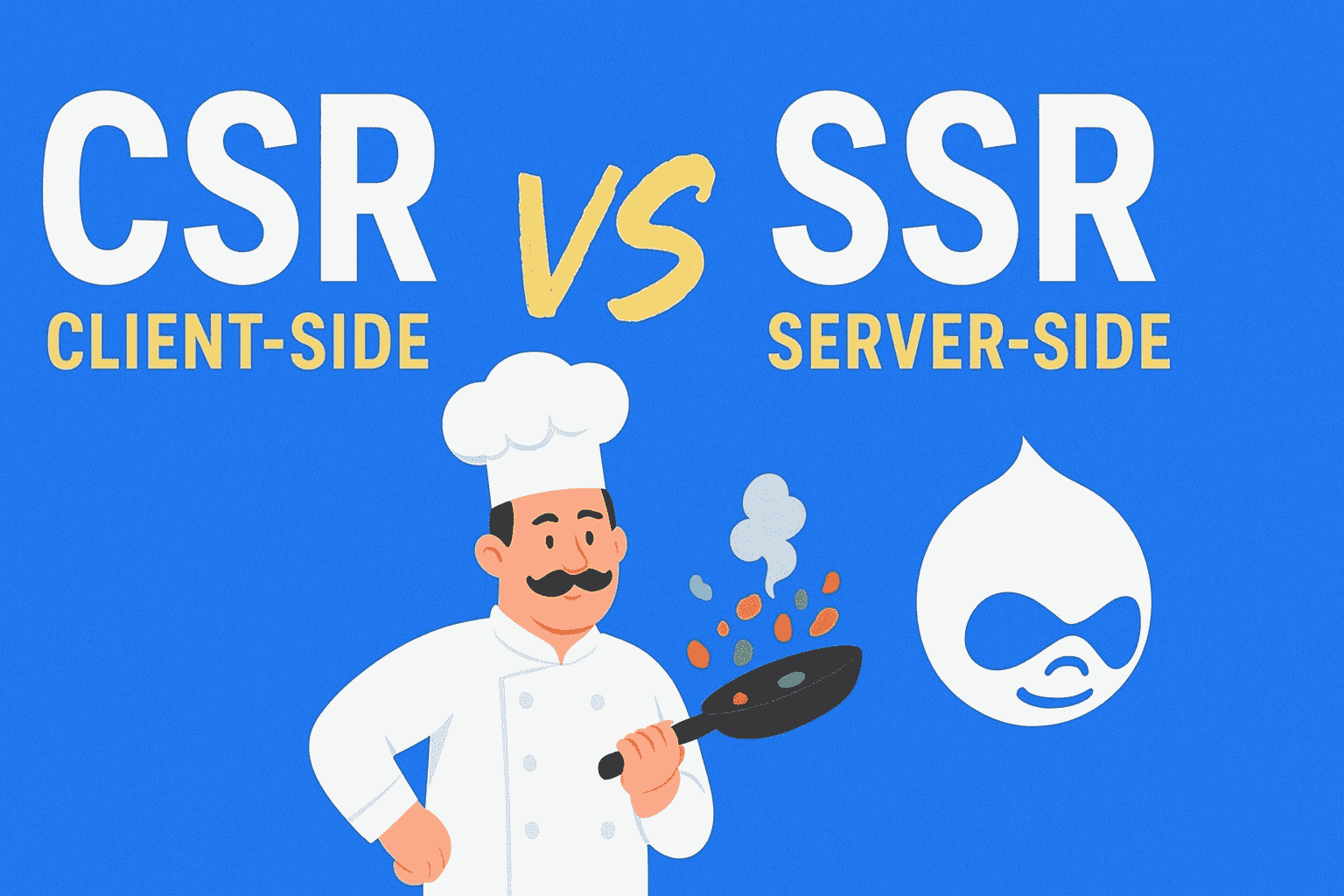Rendering strategies shape how users experience a website. They influence load speed, SEO, perceived performance, and how smooth interactions feel. In modern web development, the two dominant approaches are Client-Side Rendering (CSR) and Server-Side Rendering (SSR). Both get the job done, but in different ways—and those differences matter for Drupal developers making architectural decisions.
A Simple Everyday Analogy: Cooking at Home vs. Ordering Takeout
- CSR = Cooking at home.
You get the ingredients (JavaScript, JSON payloads), bring them into your kitchen (the browser), and assemble the meal yourself. The initial wait may feel longer because you need to prep everything. But once you’re set up, you have everything you need for quick seconds. - SSR = Ordering takeout.
The restaurant (server) cooks the full meal and hands it to you ready to eat. You get that first bite fast, but if you need a second serving or something extra, you’ll probably have to place another order.
This analogy captures the core trade-off: CSR invests more upfront for smoother interactions later; SSR gives you speed up front but hands off more work to the server.
Client-Side Rendering (CSR)
With CSR, the browser downloads JavaScript, then builds and updates the UI on the client side. Frameworks like React, Vue, and Svelte often use CSR out of the box.
Advantages
- Fast in-app interactions.
Once loaded, switching views or updating content feels instant. - Lower server load.
The server mostly returns JSON; the browser does the heavy lifting. - Rich, dynamic UI possibilities.
CSR makes advanced interactive experiences easier.
Disadvantages
- Slow initial load.
The browser must download and execute JavaScript before showing meaningful content. - SEO challenges.
Search engines can index CSR sites, but not always reliably. - Possible performance issues on weaker devices.
You’re offloading work to the client, which may not handle it well.
Server-Side Rendering (SSR)
With SSR, the server generates HTML for every page request. Traditional CMSs—including Drupal—are built around SSR by default.
Advantages
- Fast first paint.
Users see content quickly because the server sends ready-to-render HTML. - SEO friendly.
Search engines get fully rendered content instantly. - Works well on low-powered devices.
The browser doesn’t need to process heavy JavaScript to load a page.
Disadvantages
- More server strain.
Every page load requires computation. - Slower interactivity.
Dynamic UI features often require extra JS or complex hydration. - Less fluid for app-like experiences.
SSR alone can feel rigid compared to SPA-style interfaces.
Where Drupal Fits In
Drupal historically lives in the SSR world. It renders pages on the server using Twig templates, sends HTML to the browser, and finishes the job. This gives Drupal strong SEO performance, solid security, and predictable caching through systems like:
- Drupal’s dynamic page cache
- Reverse proxies like Varnish
- Edge caching through CDNs
But modern Drupal increasingly blends in CSR techniques where they make sense.
CSR + Drupal: The Decoupled or Headless Approach
If you use Drupal as a headless CMS, Drupal becomes the kitchen that ships ingredients (JSON) through APIs. The frontend—React, Next.js, Vue, SvelteKit—handles rendering in the browser.
Why teams choose CSR with Drupal
- Building app-like UIs
- High interactivity
- Custom dashboards or single-page workflows
- Clear separation between frontend developers and backend developers
But CSR-first headless setups mean you must handle:
- SEO optimization
- hydration complexity
- performance tuning
- more DevOps overhead
It’s powerful but not always the right tool.
SSR + Drupal: Traditional + Modern Hybrid Approaches
Even if Drupal handles most SSR, you can blend in modern SSR frameworks like Next.js or Nuxt when you need a hybrid environment.
Examples:
- Using Next.js to fetch Drupal content, render pages server-side, and get SEO gains.
- Using SSR for public pages while using CSR widgets inside Drupal for interactive sections.
- Using Drupal’s BigPipe for progressive rendering—Drupal sends shells first and fills dynamic parts later.
Choosing the Right Strategy in Drupal Projects
Use this quick guide:
Choose SSR (traditional Drupal) when:
- SEO is critical.
- You want fast first loads.
- The site is content-heavy (blogs, marketing sites, documentation).
- You rely on Drupal’s built-in caching layers.
- You want simplicity and stability.
Choose CSR (decoupled Drupal) when:
- You’re building highly interactive or app-like UI.
- Editors want to push content through APIs to multiple platforms.
- You need real-time features or dynamic dashboards.
- A JavaScript team owns the frontend.
Choose a Hybrid Model when:
- You want fast SEO-friendly pages but rich widgets inside.
- You want a balance between Drupal’s strengths and modern JS frameworks.
- You have selective performance hotspots that benefit from CSR.
This hybrid setup is becoming common because it brings the best of both worlds.
Final Thoughts
CSR and SSR aren’t rivals—they’re tools. The right choice depends on your goals, your performance needs, and the shape of your content. In Drupal development, the decision often comes down to how much interactivity you need and how much control you want over rendering speed and SEO.
If traditional SSR Drupal fits the job, you get a stable, performant system with strong caching. If your project needs more dynamic behavior, CSR-driven decoupled Drupal gives you the flexibility to build modern experiences.
The key is being intentional: choose the strategy that matches the experience you want your users to have, not the trend of the moment.

